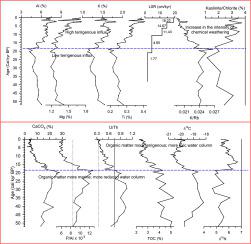Marine Geology ( IF 2.6 ) Pub Date : 2022-05-17 , DOI: 10.1016/j.margeo.2022.106825
A. Prajith , Abhishek Tyagi , P. John Kurian

|
The sediment core (MGS11/02), collected from the lower boundary of the Bay of Bengal (BoB) oxygen minimum zone (890 m) is studied to understand the influences of summer monsoon variations on the terrigenous sediment influx and its relation to bioproductivity and early diagenetic changes in the southwest BoB during the Late Quaternary. The high content of terrigenous controlled metals increased, kaolinite/chlorite increased, and K/Rb decreased after 19 cal kyr BP, indicating a simultaneous increase in the terrigenous influx and intensity of chemical weathering during this period. The variations in summer monsoon and land influx observed in the core sediments are also reflected in the sources of organic matter. High values of δ13C observed at 40 to 19 cal kyr BP suggests higher influence of marine organic matter and/or presence of C4 terrestrial plant. The negative shift of δ13C between 19 and 6 cal kyr BP could be the result of the change in terrestrial plant biomass to C3 photosynthesis and increased marine organic matter. Rock magnetic properties and redox-sensitive metals distribution suggests the prevalence of reduced environment during 52 to 19 cal kyr BP and oxic condition during 19 cal kyr BP to present. The low sedimentation during glacial period allowed sufficient time for pyritization which resulted in the low magnetic signals during 52 to 20 cal kyr BP and led to reducing conditions in the sediment interval. The δ15N values in the core sediments are suggesting the absence of denitrification in the water column during last 52 cal kyr BP. Previous studies suggest that the BoB is a geochemical ‘tipping point’ because the slight changes in water column denitrification by anthropogenic or climatic impact can accelerate BoB nitrogen contribution to the global nitrogen budget. This study indicates the absence of water column denitrification signals during last 52 cal kyr BP even though drastic climatic changes happened in the BoB in the Late Quaternary.
中文翻译:

夏季风变化对晚第四纪孟加拉湾西南湾陆源流入量、生物生产力及早期成岩作用的影响
研究从孟加拉湾 (BoB) 最低氧区 (890 m) 的下边界收集的沉积物芯 (MGS11/02),以了解夏季风变化对陆源沉积物流入量的影响及其与生物生产力和晚第四纪BoB西南部的早期成岩变化。19 cal kyr BP后陆源控制金属的高含量增加,高岭石/绿泥石增加,K/Rb下降,表明该时期陆源流入量和化学风化强度同时增加。在核心沉积物中观察到的夏季风和陆地流入的变化也反映在有机物的来源上。高值 δ 13在 40 到 19 cal kyr BP 观察到的 C 表明海洋有机物和/或 C 4陆地植物的存在的影响更大。δ 13 C 在 19 和 6 cal kyr BP 之间的负移可能是陆地植物生物量向 C 3光合作用的变化和海洋有机质增加的结果。岩石磁性和氧化还原敏感金属分布表明在 52 至 19 cal kyr BP 期间普遍存在还原环境和在 19 cal kyr BP 期间存在氧化条件。冰川期的低沉降为黄铁矿化提供了足够的时间,导致 52 至 20 cal kyr BP 期间的低磁信号,并导致沉积层段的条件降低。δ 15核心沉积物中的 N 值表明在最后 52 cal kyr BP 期间水柱中没有反硝化作用。先前的研究表明,BoB 是地球化学的“临界点”,因为人为或气候影响对水柱反硝化作用的微小变化会加速 BoB 氮对全球氮预算的贡献。这项研究表明,尽管晚第四纪的 BoB 发生了剧烈的气候变化,但在最后 52 cal kyr BP 期间没有水柱反硝化信号。

































 京公网安备 11010802027423号
京公网安备 11010802027423号